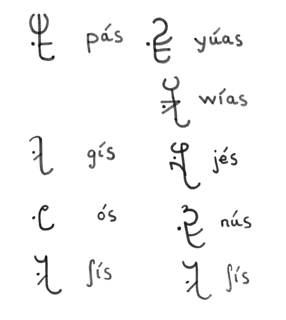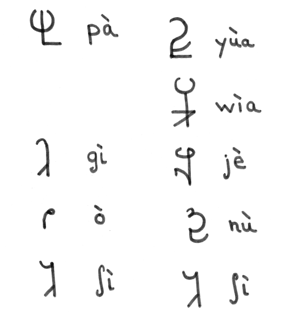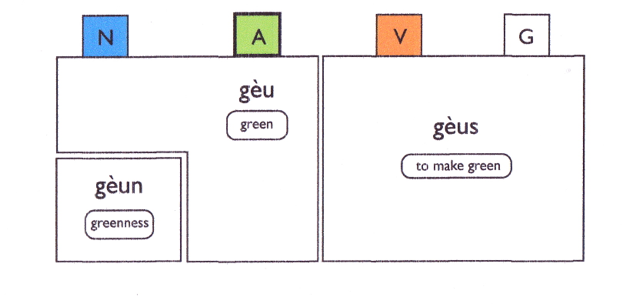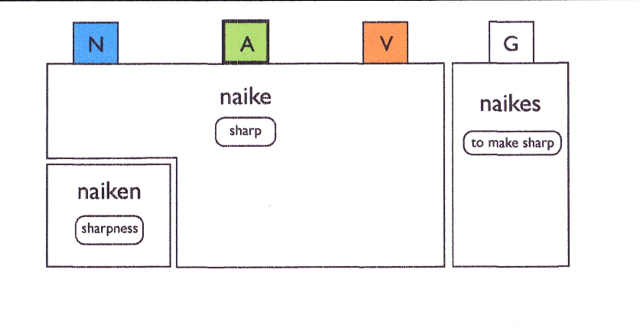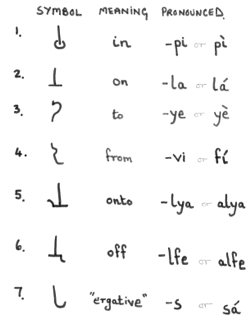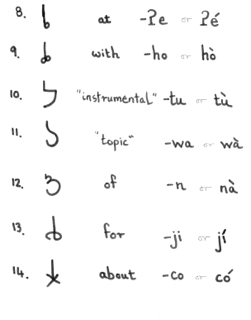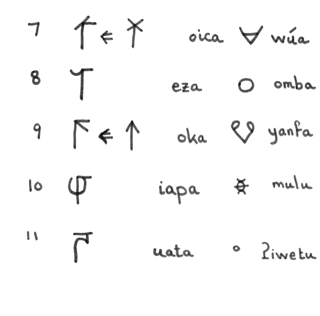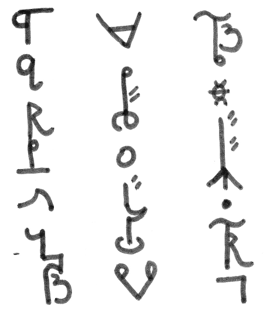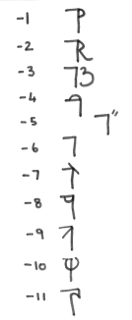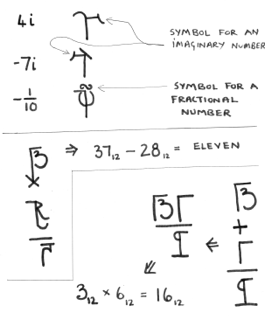Béu : Chapter 2: Difference between revisions
| Line 568: | Line 568: | ||
----- | ----- | ||
Now one quirk of ''' | Now one quirk of '''béu''' (something that I haven't heard of happening in any natural language), is that the '''pilana''' is sometimes realised as an affix to the head of the NP, but sometimes as a preposition in front of the entire NP. This behaviour can be accounted for with thing with two rules. | ||
1) The '''pilana''' attaches to the head and only to the head of the NP. | 1) The '''pilana''' attaches to the head and only to the head of the NP. | ||
2) The NP is not allowed to be broken up by a '''pilana''', the whole thing must be contiguous. | 2) The NP is not allowed to be broken up by a '''pilana''', the whole thing must be contiguous. So it this case the affix must become a preposition and be placed in front of the entire noun phrase. | ||
So if we have a NP with elements to the right of the head, then the '''pilana''' must become a preposition. The prepositional forms of the '''pilana''' are given on the above chart to the right. These free-standing particles are also written just using the symbols given on the above chart to the left. That is in writing they are shorn of their vowels as their affixed counter-parts are. | So if we have a NP with elements to the right of the head, then the '''pilana''' must become a preposition. The prepositional forms of the '''pilana''' are given on the above chart to the right. These free-standing particles are also written just using the symbols given on the above chart to the left. That is in writing they are shorn of their vowels as their affixed counter-parts are. | ||
| Line 578: | Line 578: | ||
The letters m, b, k, g and d are free to be used as abbreviations. Perhaps m <= '''mò''', two particles for joining clauses etc. etc. | The letters m, b, k, g and d are free to be used as abbreviations. Perhaps m <= '''mò''', two particles for joining clauses etc. etc. | ||
<sup>*</sup>Another case when the '''pilana''' | <sup>*</sup>Another case when the '''pilana''' must be expressed as a prepositions is when the noun ends in a constant. This happens very, very rarely but it is possible. For example '''toilwan''' is an adjective meaning "bookish". And in '''béu''' as adjectives can also act as nouns in certain positions, '''toilwan''' would also be a noun meaning "the bookworm". Another example is '''ʔokos''' which means "vowel". | ||
== ..... '''noiga''' or simple arithmetic== | == ..... '''noiga''' or simple arithmetic== | ||
Revision as of 18:30, 4 October 2012
..... The parts of speech of béu
"Parts of speech" is linguistic jargon, which is referring to the different "classes" of words a language might have. For example "nouns", "verbs", etc. etc.
In fact nouns(N), verbs(V) and adjectives(A) are the big three, and after some debate over the last 30 years, it has been agreed that every language has these three word classes.
In béu a noun is called cwidau (cwì meaning a physical object), a verb is called jaudau (jàu meaning "to move"), and an adjective is called saidau (sái meaning "a colour").
There are other classes of words in béu as there are in other languages. béu has adverbs (wedau) but these don't really come into their own, being more a form an adjective takes in certain situations. Also a lot of words that are called adverbs in English are called particles(P) yonʔako in béu. Particles are a type of hold-all category for a word that doesn't fit into any of the other classes. Under the term "particle" many subclasses can be defined, and in fact some subclasses have a class membership of one. Anyway we will not talk about particles again. But if you come across a word that can not be equated with any of the other word classes ... well then you know that you have a particle.
To made béu easy to talk about we will define another part of speech called the gomua. In actual fact it is a form of verb. A form usually called the "infinitive" in the Western linguistic tradition. But I prefer the term gomua (G).
To go into it a bit more ... gomua means tail-less (goma = tail). For example solbe means "to drink" and this is gomua.
In contradistinction to gomua we have gomia (actually jaudau gomia to give the concept its full title). gomia means tail-having.
For example solbarin (I drank, so they say) is gomia.
solbarin is built up from the gomua base solbe.
First you delete the final vowel, then you add "a" meaning first person singular subject, then "r" means that this is not imperative and not subjunctive, then "i" means simple past tense, then "n" is an evidential, meaning that the utterance is based on what other people have said.
solbarin is gomia pomo or "a full tail verb".
The three evidential markers are all optional, so they can quite easily be dropped. solbari (I drank) is what is called gomia yàu or "a long tail verb".
solbis (you lot drink) and solbon (let him drink) are gomia wái or "a short tail verbs" ... the first is an example of the imperative and the second is an example of the subjunctive (more linguistic jargon ... sorry).
solbai is called an part verb ???
By the way, while we are at it (defining linguistic terms), semo = a clause (from the verb "to say" sema), semoza = a sentence
nandau (word) has been given already.
..... Building up a noun phrase "cwidauza"
Now we talk about the béu noun phrase (cwidauza). This can be described as ;-
Quantifier1 Head2 (Adjective3 x n) Genitive4 Determiner5 Relative-clause6
1) The Quantifier is either a number or a word such as "all", "many", "a few" etc.
2) The head is usually a noun but can also be an adjective. When you come across an adjective as head of a noun phrase, its meaning is "the person/thing that is "adjective" ".
3) An adjective ... not much to say about this one, you can have as many as you like, the same as English.
4) A Genitive is made from a noun (and I guess an adjective as defined in 2) ) with an n suffix. It says that the head has some quality or relationship to the genitive.
5) Either dí "this", or dè "that".
6) This is a clause, beginning with tà that qualifies the head of the noun phrase.
An interesting point is that in the absence of a "head" any of the other 5 elements can constitute a NP by itself.
..... Another type of noun phrase ... "gomuaza"
gomuaza has at its heart gomua. Every gomuaza haa an equivalent clause, which of course have gomia as their heart.
The clause has free word order. However the word order of the gomuaza is fixed. For example;-
(pás) solbari moze sacowe or (pás) solbari saco moze => I drank the water quickly
As a gomuaza this clause would be pà solbe moze saco => My drinking of the water quickly. ... Note that pà can not be dropped. Also it is in its plain or unmarked form (i.e. no -s stuck on).
Note the word order ... "A" argument followed by gomua followed by "O" argument followed by adverb (any other peripheral arguments are stuck on at the end).
A gomuaza has the same roll in a sentence as a normal noun phrase (cwidauza). For example
sa RAF kalme Luftwaffe kyori Hitlerye olga tena => The RAF's destruction of the Luftwaffe, made Hitler think again. ... here a gomuaza acts as the A-argument.
Notice that the above sentence has the exact same structure as the first sentence of the previous section.
Also note that Hitler olga tena would be gomuaza with the meaning "Hitler's thinking again". However Hitlerye olga tena is not. For one thing, no pilana is allowed to "split" a gomuaza. However olga tena certainly is.
..... Pronouns and what is meant by S, A and O
béu is what is called an ergative language. About a quarter of the world languages are ergative or partly ergative. So let us explain what ergative means. Well in English we have 2 forms of the first person singular pronoun ... namely "I" and "me". Also we have 2 forms of the third person singular male pronoun ... namely "he" and "him". These two forms help determine who does what to whom. For example "I hit him" and "He hit me" have obviously different meanings (in English there is a fixed word order, which also helps. In béu the word order is free).
timpa = to hit ... timpa is a verb that takes two nouns (LINGUISTIC JARGON ... a transitive verb).
pás ò timpari = I hit him pà ós timpori = He hit me ... OK in this case the protagonist marking in the verb also helps to make things disambiguous. But this will not always help, for example when both protagonists are third person singular.
So far so good. And we see that English and béu behave in the same way so far. But what happens when we take a verb that takes only one noun (LINGUISTIC JARGON ... a transitive verb). For example doika = "to walk". In English we have "he walked". However in béu we don't have *ós doikori but ò doikori (equivalent to saying "*him walked" in English). So this in a nutshell is what an ergative language is.
It is the convention to call the doer in a intransitive clause the S argument. For example òS flomporta = She has tripped
It is the convention to call the doer in a transitive clause the A argument. For example ósA timpori jene = He hit Jane
It is the convention to call the "done to" in a transitive clause the O argument. For example ós timpori jeneO = He hit Jane
The S was historically from the word "Subject" and the O historically from the word "Object", but it is best just to forget about that. In fact when I use the word "subject" I am talking about either the S argument or the A argument.
If you like you can say ;-
In English "him" is the "done to"(O argument) : "he" is the "doer"(S argument) and the "doer to"(A argument).
In béu ò is the "done to"(O argument) and the "doer"(S argument) : ós is the "doer to"(A argument).
Below are two tables showing the two forms of the béu pronouns.
| I | pás | we (includes "you") | yúas |
| we (doesn't include "you") | wías | ||
| you | gís | you (plural) | jés |
| he, she | ós | they | nús |
| it | ʃís | they | ʃís |
| me | pà | us | yùa |
| us | wìa | ||
| you | gì | you (plural) | jè |
| him, her | ò | them | nù |
| it | ʃì | them | ʃì |
There could be another member it the above table. When a action is performed by somebody on themselves, a special particle tí is used.
Just as in English, we do not say "*I hit me", but "I hit myself" ... in béu we do not say *pás pà timpari, but pás tí timpari.
LINGUISTIC JARGON ... "myself" is what is called a "reflexive pronoun". In English there are many reflexive pronouns (i.e. "myself", "yourself", "herself", etc. etc.) : in béu only one.
One other point ... béu has generally a pretty free word order. But in a sentence such as jene tí laudori (Jane washed herself) it would be pretty unusual to have the tí before jene
There is an emphatic pronouns based on the possessed form of bùa "body". The emphatic forms are given below ;-
| me myself | bapua | we ourselves | bayua |
| we ourselves | bawua | ||
| you yourself | bigua | you yourselves | bejua |
| him himself, her herself | bonua | them themselves | bunua |
| it itself | bisua | them themselves | bisua |
The above forms come just after the normal pronouns and the two words stand in apposition. If a pilana is applied to one, it must be applied to the other as well. For example ;-
pás bapuas ò timparu => I myself will hit her
..... 64 Adjectives
| good | bòi* | bad | kéu |
| long | yàu | short | wái |
| high, tall | hái | low, short | ʔàu |
| right, positive | lugu | left, negative | liʒi |
| white | ái | black | àu |
| young | sài | old (of a living thing) | gáu |
| clever, smart | jini | stupid, thick | tumu |
| near | nìa | far | múa |
| new | yaipe | old, former, previous | waufo |
| big | jutu | small | tiji |
| hot | fema | cold | pona |
| open | nava | close | mapa |
| simple, easy | baga | complex, difficult, hard | kaza |
| sharp | naike | blunt | maubo |
| wet | nuco | dry | mide |
| empty | fene | full | pomo |
| fast | saco | slow | gade |
| strong | yubu | weak | wiki |
| heavy | wobua | light | yekia |
| beautiful | hauʔe | ugly | ʔaiho |
| contiguous, touching | yotia | apart, separate | wejua |
| fat | somua | thin, skinny | genia |
| bright | selia | dull, dim | golua |
| thin | pilia | thick | fulua |
| east, dawn, sunrise | cúa | west, dusk, sundown | dìa |
| tight | taitu | slack, loose | jauji |
| neat | ilia | untidy | ulua |
| soft | fuje | hard | pito |
| wide/broad | juga | narrow | tisa |
| rough | gaʔu | smooth | sahi |
| deep | gubu | shallow | siki |
| right | sèu | wrong | gói |
In the above list, it can be seen that each pair of adjectives have pretty much the exact opposite meaning. However in béu there is ALSO a relationship between the sounds that make up these words.
In fact every element of a word is a mirror image (about the L-A axis in the chart below) of the corresponding element in the word with the opposite meaning.
| ʔ | ||||
| m | ||||
| y | ||||
| j | au | |||
| f | o | |||
| b | oi | |||
| g | i | |||
| d | ia | high tone | ||
| l | =========================== | a | ============================ | neutral |
| c | ua | low tone | ||
| s/ʃ | u | |||
| k | eu | |||
| p | e | |||
| t | ai | |||
| w | ||||
| n | ||||
| h |
* Note that the adverb version of this word is slightly irregular. Instead of boiwe it is bowe. People often shout this when impressed with some athletic feat or sentiment voiced ... bowe bowe => well done => bravo bravo
Also instead of keuwe we have kewe. People often shout kewe kewe kewe if they are unimpressed with some athletic feat or disagree with a sentiment expressed. Equivalent to "Booo boo".
..... Adjectives and how they pervade other parts of speech
Earlier on in this chapter we discussed parts of speech. In béu, sometimes, an unmodified word can belong to 2 or 3 different parts of speech at once.
Also earlier on I introduced the gomua (G) or the infinitive, as a part of speech. This is the "base form" of the verb and it resembles a noun in many respects. It is being treated as a seperate part of speech ... just for convenience really. I do not want to get into an argument about linguistic theories etc. etc. This is just to make things easy to discuss.
Let us start of with a single-syllable adjective. Let us see what forms a single-syllable adjective can take and what "parts of speech" these forms can belong to. Consider the word gèu "green" ;-
Along the top of the above chart you can see N, A, V and G (noun, adjective, verb and gomua).
The form under these 4 headings, shows the form géu takes when it is one of these 4 parts of speech. gèu is fundamentally an adjective (that is what the thicker border around the "A" means).
You can see that we have two nouns forms in the above chart. One has its original form, I call this one "the substansive noun" (meaning "the green one"). The other changes its form by taking the affix -n. I call this one "the qualitative noun" (meaning "greenness").
We can see that we can derive a verb from géu. By affixing -s we get an transitive verb meaning "to make green". You can see that the V-forms and the G-forms are the same.
Actually the V-form is not gèus. The V-form is actually a myriad of forms. But they are all built up from the gèus foundations. As an example let us build up one of the myriad of forms that the V-form can take. First we add a vowel, either a, i, o, u, e, au or ai, that represents the subject ... then we add, either r, n or s (depending on if we want the indicative mood, the subjunctive nood or the imperative) ... then we add a vowel (or consonant + vowel) as a tense/aspect marker, either ??? ... then we possibly add an evidential marker, either n, s or a. So we could get geus + i + r + i +a => geuʃiria = "you became green, I saw it" ... one of the many forms considered as a V-form.
OK. We have seen how a single-syllable adjective works. Now for a 2-syllable adjective. Consider the word naike "sharp" ;-
We can see that in this case it is possible to have 3 parts of speech from only one form. However in this case the "finite" verb (V) is built up directly from naike and not from the G-form. So, for example, we have naikiria = "you sharpened (it), I saw you do it". Rather than *naikeʃiria.
And above we see one more possibility. In the above two examples you can get to the "G" form from the "A" form by a regular process. With mapa/mapau this is not possible. So it appears that this word has two base forms ("A" and "G") and this word would have two entries in a dictionary.
Notice that all the derived verbs are transitive. There are three ways that we can make an intransitive clause.
1) pintu tí mapori = The door closed itself ... this form strongly implies that there was no human agent. Possibly the wind closed the door (or a supernatural element when it comes to that).
2) pintu bwori mapau = The door was closed ... this is the standard passive form. It strongly implies a human agent but the agent is either unknown or unimportant.
3) pintu lí mapa = The door became closed ... this uses the adjective form of mapa and the "copula of becoming" láu. This form has no implication as to the humanness of the agent.
By the way, the G-form of nava "open" is navai
Let us go back to gèu and consider gèu in an intransitive clause. As above we have 3 ways.
1) báu tí geusori = The man made himself green ... this form implies that there was some effort involved.
2) báu bwori gèus = The man was made green ... this is the standard passive form. It strongly implies a human agent but the agent is either unknown or unimportant.
3) báu lí gèu = The man became green ... this uses the adjective form of gèu and the "copula of becoming" láu. This form has no implication as to the humanness of the agent.
Any single syllable adjective, must have the suffix du in all its verbal forms. For example ;-
àus = to blacken, maŋkeu = faces
ausuri maŋkiteu = they blackened their faces ... interesting construction ... we use the transitive form even tho' they perform the action on themselves.
..... pilana or the case system
..
These are what in LINGUISTIC JARGON are called "cases". The classical languages, Greek and Latin had 5 or 6 of these. Modern-day Finnish has about 15 (it depends on how you count them, 1 or 2 are slowly fading away). Present day English still has a relic of a once more extensive case system : most pronouns have two forms. For example ;- the third-person:singular:male pronoun is "he" if it represents "the doer", but "him" if it represents "the done to".
The word pilana is built up from ;-
pila = to place, to position
pilana <= (pila + ana), in LINGUISTIC JARGON it is called a "present participle". It is an adjective which means "putting (something) in position".
As béu adjectives freely convert to nouns*, it also means "that which puts (something) in position" or "the positioner".
Actually only a few of them live up to this name ... nevertheless the whole set of 14 are called pilana in the béu linguistic tradition.
..
The pilana are suffixed to nouns and specify the roll these nouns play in the clause**.
The pilana are abbreviated to a single consonant in the béu writing system. That is, in the béu writing system, the final vowel of all pilana is invisible***.
The pilana are partly an aid to quicker writing. However they also demarcate a set of 14 affixes and make quite a neat system.
You could call these 14 plus the unmarked noun a case system of 15 cases. Well you could if you wanted to (up to you).
Note that -lya and -lfe are represented by a special amalgamated symbols which do not occur elsewhere.
Notice that by a addition of pilana, you might expect to get the forms alye and alfi. As you can see this is not the case. Perhaps the amalgamated form has the final vowel changed under the pull of the initial vowel, a.
* You can tell if pilana is being an adjective or a noun by the environment that you find it in.
** Well actually that is not true of pilana number 12 : "-n" modifies a noun in a noun phrase.
***Maybe a corollary of the béu habit of dropping verbal arguments, when it is at all possible :-)
Now one quirk of béu (something that I haven't heard of happening in any natural language), is that the pilana is sometimes realised as an affix to the head of the NP, but sometimes as a preposition in front of the entire NP. This behaviour can be accounted for with thing with two rules.
1) The pilana attaches to the head and only to the head of the NP.
2) The NP is not allowed to be broken up by a pilana, the whole thing must be contiguous. So it this case the affix must become a preposition and be placed in front of the entire noun phrase.
So if we have a NP with elements to the right of the head, then the pilana must become a preposition. The prepositional forms of the pilana are given on the above chart to the right. These free-standing particles are also written just using the symbols given on the above chart to the left. That is in writing they are shorn of their vowels as their affixed counter-parts are.
The letters m, b, k, g and d are free to be used as abbreviations. Perhaps m <= mò, two particles for joining clauses etc. etc.
*Another case when the pilana must be expressed as a prepositions is when the noun ends in a constant. This happens very, very rarely but it is possible. For example toilwan is an adjective meaning "bookish". And in béu as adjectives can also act as nouns in certain positions, toilwan would also be a noun meaning "the bookworm". Another example is ʔokos which means "vowel".
..... noiga or simple arithmetic
Above right you can see the numbers 1 -> 11 displayed. Notice that the forms of 1, 3, 6, 7 and 9 have been modified slightly before the "number bar" has been added.
In the bottom right you can see 7 interesting symbols. These are used to extend the range of the béu number system (remember the basic system only covers 1-> 1727). Their meanings are given in the table below.
| elephant | huŋgu |
| rhino | nàin |
| water buffalo | wúa |
| circle | omba |
| hare | yanfa |
| beetle | mulu |
| bacterium, bug | ʔiwetu |
To give you an idea of how they are used, I have given you a very big number below.
Which is => 1,206,8E3,051.58T,630,559,62 ... E represents eleven and T represents ten ... remember the number is in base 12.
O.K. this number has a ridiculous dynamic range. But this is for demonstration purposes only: if you can handle this number you can handle any number.
This monster would be pronounced aja huŋgu uvaila nàin ezaitauba wúa idauja omba idaizaupa yanfa elaibau mulu idaidauka ʔiwetu elaivau dó
Now the 7 "placeholders" are not really thought of as real numbers, they are markers only. Used in the same way that we would say "point"/"decimal" when reeling off a number.
When first introduced to this system, many people think that the béu culture must be untenable, however strangely enough the béu culture has lasted many thousands of year, despite the obvious confusion that must arise when they attempt to count elephants.
One further point of note ...
If you wanted to express a number represented by digits 2->4 from the LHS of the monster, you would say auvaidaula nàin .... the same way as we have in the Western European tradition. However if you wanted to express a number represented digits 6 ->8 from the RHS of the monster, you would say yanfa elaibau .... not the way we do it. This is like saying "milli 630" instead of "630 micro".
To make a number negative the "number bar" is placed on the left. See below ;-
Also a number can be made imaginary by adding a further stroke that touches the "number bar". See below ;-
As you can see above, there is no special sign for the "addition operation". The numbers are simply written one beneath the other. Similarly with subtraction but one number would be negative this time.
There is a special sign to indicate multiplication (+), and there is an equals sign (-).
Division is the same as multiplication except that one of the numbers is in "fractional form".
There is an alternative multiplication/division notation : instead of using the + sign, the two quantities can instead be written side by side (see the example above).
-6 is pronounced ela liʒi ... liʒi means left or "negative
By the way lugu means right (as in right-hand-side) or positive.
4i is pronounced uga haspia ... and what does haspia mean, well it is the name of the little squiggle that touches the number bar, for one thing.
-4i is pronounced uga haspia liʒi
-1/10 is pronounced diapa liʒi
i/4 is pronounced duga haspia
And so ends chapter 2 ...
Index
- Introduction to Béu
- Béu : Chapter 1 : The Sounds
- Béu : Chapter 2 : The Noun
- Béu : Chapter 3 : The Verb
- Béu : Chapter 4 : Adjective
- Béu : Chapter 5 : Questions
- Béu : Chapter 6 : Derivations
- Béu : Chapter 7 : Way of Life 1
- Béu : Chapter 8 : Way of life 2
- Béu : Chapter 9 : Word Building
- Béu : Chapter 10 : Gerund Phrase
- Béu : Discarded Stuff
- A statistical explanation for the counter-factual/past-tense conflation in conditional sentences
